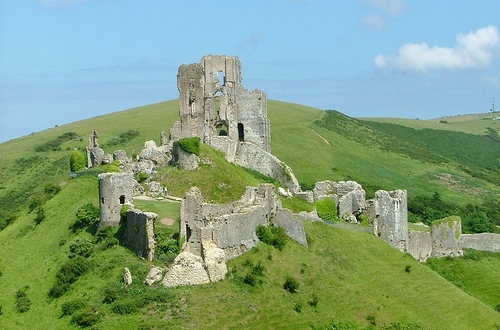

Location: Dorset Map
Tel. 01929 481294
Open: daily

Corfe Castle is a medieval citadel situated on a hill overlooking a town of Corfe in Devon County in United Kingdom. Corfe Castle was constructed in the 11th century by the orders of William the Conqueror to secure newly conquered lands. The citadel suffered great degree of damage during English Civil War. Corfe Castle was owned by Sir John Bankes at the time when Royalists started battling the Parliamentary forces. The wife of the owner Lady Mary Bankes was forced to take charge of castle's defenses. The first siege by the Parliamentary army in 1643 was repulsed, however two years later in 1645 one of the last Royalist strongholds finally fell to the enemy. Local legends claim that ruins of Corfe Castle were visited by a headless "White Lady" shortly it was wiped destroyed by Cromwell's Parliamentary army. Some people who came too close to her heard moaning and crying of a mysterious woman. In March of the same year the Corfe Castle was reduced to ruins. It lost any military value and was abandoned.

The name Corfe comes from the Anglo-Saxon and means the valley in which the village and the castle ruins are located. Translated, Corfe Castle roughly means valley castle or castle in the valley.
Saxon settlement
At the end of the 9th century, under Alfred the
Great, the first fortifications were built in Corfe to protect them from
the Danes. According to legend, the English King Edward the Martyr was
murdered in the castle on March 18, 978.
Construction of the
castle in the Middle Ages
After the Norman conquest of England,
around 1090, the Normans began building a castle from the local
limestone on the site of the old fortifications. Under Henry I
"Beauclerc" around 1105 the mighty keep was created. At the beginning of
the anarchy, the castle, defended by Baldwin de Redvers, was
unsuccessfully besieged by King Stephen in 1139. The castle was further
expanded under King Johann Ohneland. He stayed in the castle frequently,
used it as a place to keep the crown jewels and as a prison. In 1202, 25
French knights captured during the Anglo-Prussian War attempted to break
out. However, they could only occupy the Keep, where they would rather
starve than surrender. 22 of the knights died, three survivors were
eventually overpowered. John's niece Eleanor of Brittany and, in the
14th century, King Edward II were also imprisoned at Corfe Castle. The
outer courtyard was completed under Edward I. In the 14th century the
castle was neglected until Edward III. had it repaired between 1356 and
1377. After the Wars of the Roses, Henry VII had it extended as a
residence for his mother Margaret Beaufort. After their death, the
castle reverted to the crown. In 1572, Elizabeth I sold it to her future
Lord Chancellor, Christopher Hatton, who continued to fortify the castle
in the face of the threat of the Spanish Armada. In 1635 Sir John
Bankes, later Chief Justices of the Common Pleas, acquired the castle.
English Civil War
In 1643, during the English Civil War, the
castle was besieged by troops of the Parliamentarians ("Roundheads").
Commanded by Royalist Lady Mary Bankes, the castle withstood the siege
for six weeks, after which the Parliamentarians withdrew after losing
100 men. Three years later, in 1646, the castle was besieged a second
time. After a two-month siege, the castle garrison was betrayed by one
of its members in February 1646. After the Parliamentarians took over,
the Bankes family was allowed to leave the castle. The castle was blown
up by sappers. The local population used the stones and other materials
from the castle to build their houses.
Modern times
After the
Civil War, Ralph Bankes built Kingston Hall at Wimborne Minster in 1663
as the new family home. The remains of Corfe Castle remained in the
Bankes family until 1982, when Ralph Bankes gave it to the National
Trust. After the danger of the keep collapsing in 2006, the upper ruins
can now be visited again. In 2019, Corfe Castle was visited by around
260,000 people.
The castle is owned by the National Trust, who have set up a gift
shop in Market Square. In 2002, the castle, which is open to tourists
all year round, had 167,582 visitors.
In Corfe Castle's market
square stands the Corfe Model Village, a 1:20 scale replica of the
castle and village before it was destroyed. It was created by Eddie
Holland from 1964 to 1966.
The ruin served u. a. as a backdrop for the television series Treasure Island, which was filmed in 1957 based on Enid Blyton's Friendship series of children's books, and for the 2008 film adaptation of the d'Urbervilles' novel Tess.